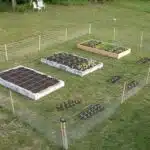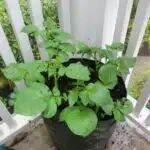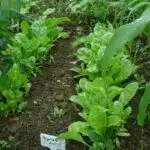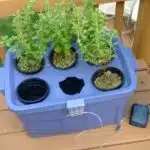Planting the perfect plot of produce can be quite a quandary for gardeners. With so many methods and techniques, it’s hard to know which will result in the ripest results. But one gardening practice that has gained popularity in recent years is square foot gardening – an intriguing technique with a number of pros and cons.
Square foot gardening is an organized and efficient way to grow fruits, vegetables, herbs, and flowers. It’s easy to set up a square foot garden bed without spending much money or effort, making it accessible to everyone from beginner gardeners to experienced green thumbs. The method utilizes raised beds divided into 12-inch squares and filled with soil mixes specifically designed for this type of gardening.
Square foot gardening has become increasingly popular because of its versatility, but does it really work? In this article we’ll dive deep into the ground rules of square foot gardening and explore both the positive and negative aspects so you can decide if this approach is right for your garden.
What Is Square Foot Gardening?
If you’ve ever wanted to try your hand at gardening, but don’t have a lot of space to work with, you may be in luck. Square foot gardening is like a breath of fresh air for those of us who don’t have the luxury of expansive outdoor space. To put it simply, square foot gardening is exactly what it sounds like – growing plants in small, defined areas. It’s a great way to maximize yield with minimal effort and land.
Think of it as an organized approach to gardening. You can easily map out your garden area into a grid pattern; taking into account how much sun each square will get and which plants will thrive best in those conditions. This allows you to plan where everything should go and maximize your yield. Additionally, by using raised beds and containers, it reduces the amount of weeding required since the soil won’t be compacted or mixed up with weeds from adjacent plots.
Square foot gardening also eliminates problems such as uneven water distribution or overcrowding plants that happens when planting directly into the ground. With this method, you can easily keep track of which plants need more attention and make sure they’re getting enough nutrients without over-watering or over-fertilizing other parts of the garden. This makes managing your garden easier than ever before!
Benefits Of Square Foot Gardening
Planting with precision pays off when it comes to square foot gardening. This innovative approach to gardening offers plenty of perks that can make your outdoor space flourish. From bountiful blooms and abundant harvests to easier maintenance and less waste, there are many benefits to be enjoyed with this popular style of planting.
Firstly, square foot gardening is an ideal way to maximize the potential of a small area. By breaking the garden into neat squares, you can get the most from the space and make sure each plant has enough room to thrive without overcrowding. Additionally, this method helps you keep track of where everything is planted and makes it much easier for weeding or harvesting.
Another advantage of square foot gardening is that it requires less work overall than traditional row-style gardens do. You don’t have to dig up large swaths of soil each season, as you only need to focus on maintaining individual squares or beds. You also don’t need to worry about hilling up potatoes or other labor-intensive tasks since they’re not necessary with this type of garden design. Furthermore, by planting in blocks rather than rows, you can save money on seeds and reduce water waste due to better irrigation techniques.
With its many advantages, it’s no wonder why square foot gardening continues to be a popular choice for gardeners looking for an efficient yet effective way to cultivate their green spaces. The right plant selection for your square foot garden will ensure that you reap all its benefits for years to come!
Plant Selection For Square Foot Gardening
When it comes to square foot gardening, plant selection is especially important. Each square of the garden should contain a single type of vegetable, as this helps ensure that plants receive adequate amounts of space, light and nutrition. It’s also important to choose varieties that mature in the same amount of time so they can be harvested together. Additionally, planting vegetables with similar water needs in one square can help simplify watering.
When considering what types of vegetables to grow, consider the climate and soil type for your area. Some vegetables may require more sun or heat than others, so it’s essential to pick crops that will thrive in your location. The same goes for soil types; if you have clay soil, then you’ll want to choose vegetables that don’t require overly fertile soil.
Selecting the right sizes of plants is also key; some plants, such as tomatoes and peppers, need more room to spread out and thrive while others, like lettuce and radishes, do better in smaller spaces. Once you’ve chosen your plants and placed them in their designated spots within the garden bed, be sure to give them enough water for healthy growth! With the right plant selection and care, square foot gardening can be a great way to grow your own food at home!
Square Foot Gardening Supplies
The supplies for square foot gardening are akin to a brave explorer packing his bag before heading out on an adventure. It is essential that the adventurer take all the necessary items, from tools and seeds to water and soil, to ensure a successful journey. Similarly, it’s important for the avid gardener to have all the right supplies in hand when beginning their own square foot garden.
Just like any other endeavor, having the right supplies can make or break a square foot garden. For instance, one must consider the type of soil they will be using in their garden – will it be potting mix or compost? Moreover, which tools might be needed to properly cultivate and nurture seedlings? A spade may come in handy when it comes time to spread out soil evenly throughout your plot; perhaps some pruning shears may be used if you decide to plant a few shrubs or trees. Additionally, don’t forget about watering cans and hoses!
The list of necessary supplies is seemingly endless but also totally worth it – with all these elements in place, your garden will flourish! As you prepare for this exciting project, take inventory of what you already have and what needs to be acquired so that nothing is overlooked. This way you can confidently move onto the next step: ensuring the soil requirements for square foot gardening are met!
Soil Requirements For Square Foot Gardening
Square foot gardening is like a puzzle piece, interlocking with the environment in perfect harmony. Its soil requirements are carefully calculated to ensure that plants can get the right amount of nutrients and thrive. With this type of gardening, you can create an efficient and beautiful garden in a small space.
The soil needs to be light and well-drained, made up of equal parts compost, peat moss and vermiculite or perlite. It should also have plenty of organic matter such as aged manure or composted leaves added to it. If you are growing vegetables, you need to make sure that the soil is rich in nitrogen so that your plants will have enough energy for growth.
When preparing the soil for square foot gardening, it’s important to use materials that will provide drainage and aeration for the roots. This will help prevent waterlogging and encourage healthy root growth. You should also aim to maintain a neutral pH balance in the soil – ideally between 6 and 7 – as this is when most plants are able to absorb nutrients most effectively.
By following these guidelines and understanding its unique requirements, square foot gardening can be an effective way of creating a vibrant garden with minimal effort – allowing nature itself to do most of the work! From this foundation, we can move on to exploring how design and layout further enhances our square foot gardens.
Design And Layout Of Square Foot Gardening
“Necessity is the mother of invention”, and this could not be truer when it comes to square foot gardening. This innovative form of gardening has revolutionized the way we can grow plants in limited space, while ensuring they get all the nutrients they need. But, what does it take to make a successful square foot garden? Let’s explore the design and layout of square foot gardening.
The first step in designing a square foot garden is determining its size and shape. Depending on the available space, you will want to decide if you have room for a single container or multiple ones. Once you have that settled, you will determine how many squares are needed for each container—this will depend on the type of plants being grown. The next step is to make sure your containers are placed in an optimal spot with plenty of sunlight and access to water.
Finally, the most important aspect of square foot gardening is deciding which plants should go into which squares. To ensure success, choose plants that are suited for your region’s climate and soil type, as well as those that can live in close proximity to one another without competing for resources like sunlight or water. With these factors in mind, organizing your square foot garden should be easy enough! Transitioning now into seed starting in square foot gardening…
Seed Starting In Square Foot Gardening
Seed starting is an important part of square foot gardening. It can be done indoors or outside, depending on the type of seed. Seeds started indoors need to be carefully monitored to make sure they get enough light and water. They also need to be replanted into larger pots as they grow, so space must be taken into consideration when deciding how many seeds to start.
Outdoor seed starting has its own set of considerations. Planting depth, soil temperature, and water requirements must all be taken into account in order for the seeds to germinate properly. Additionally, timing is critical; if planted too early or too late, the seeds won’t have a chance to reach maturity before winter sets in.
Luckily, with careful planning and preparation, anyone can have success with seed starting in square foot gardening. With some practice and patience, you’ll soon have a thriving garden full of homegrown vegetables! With that foundation laid down, it’s time to turn our attention to plant care in square foot gardening.
Plant Care In Square Foot Gardening
Plant care is a crucial part of square foot gardening. To keep your plants healthy and thriving, it’s important to pay attention to their individual needs. This includes things like providing adequate sunlight, water, and nutrients. It also means being aware of signs of disease or pests and taking appropriate action.
Watering is the most important aspect of plant care. You want to make sure you’re not over-watering or under-watering your plants. In general, most vegetables need about an inch of water every week. If you’re using a sprinkler system, adjust the settings so that it’s delivering the correct amount for each type of plant in your garden bed.
For fertilizer, compost is the best option for square foot gardens because it’s natural and provides a slow release of nutrients that will last all season long. Additionally, you can use liquid fertilizers but make sure they are organic and specifically designed for vegetable gardens. Use them according to package instructions as over-fertilizing can have serious consequences on your plants’ health. With proper plant care, your square foot garden should produce abundant yields throughout the season! Now we look at how to prevent pests from infiltrating your plot and ruining your hard work!
Pest Control In Square Foot Gardening
When it comes to gardening, pests can be a major problem. But what about when it comes to square foot gardening? In this article, we’ll explore the pest control methods for square foot gardening and look at the pros and cons of each.
First off, let’s take a look at some of the natural ways to keep pests away from your plants. The most common solution is installing mesh netting over the beds. This will prevent insects like moths and butterflies from laying eggs in your soil, which could otherwise lead to an infestation. Crop rotation is another popular option for pest control in square foot gardening; this involves planting different crops in different beds every season so that pests aren’t able to build up immunity to any particular crop.
Now let’s consider chemical-based solutions for controlling pests. These include using insecticides or herbicides on the soil or leaves of plants in order to kill off any unwanted insects or weeds. While these methods are effective, they can also be harmful to other beneficial bugs and even animals if used incorrectly or too often, so great care should be taken when using them.
No matter what method you choose for pest control in your square foot garden, it is important to remember that prevention is key – keeping your garden clean and free of debris will go a long way towards preventing an infestation from occurring in the first place! Now that we’ve looked at the pros and cons of pest control for square foot gardens, let’s move on to discussing watering and irrigation for these gardens.
Watering And Irrigation For Square Foot Gardening
Watering and irrigation is an essential part of square foot gardening. The soil in a SFG needs to be kept moist, but not overly saturated, as this can lead to root rot or fungus. It’s important to water the garden with enough consistency that the plants receive a deep, thorough watering each time. To ensure even distribution of water and keep the soil from becoming too hard, use a soaker hose or drip irrigation system.
When using a soaker hose or drip system, it’s important to check that there are no clogs or leaks. The timing of watering also matters: if you have a hot climate, it’s best to water in the morning or evening when temperatures are cooler and less evaporation occurs. Additionally, don’t forget to add mulch around your plants; this helps retain moisture in the soil and reduces weeds.
Ultimately, watering and irrigation are key components of successful square foot gardening. Ensuring proper hydration for plants is vital for their growth and health and can make all the difference between success and failure in your SFG bed. With careful planning and monitoring of water levels, you’ll have lush vegetables ready for harvest in no time!
Mulching And Soil Amendments For Square Foot Gardening
Bringing your square foot garden to life is a bit like painting a picture – you have the basic framework of your canvas, but need to add layers of color, texture and detail to finish it off. Mulching and soil amendments are the finishing touches that can transform your garden into something extraordinary.
Soil amendments can help to improve soil structure, provide essential nutrients and increase water holding capacity. Incorporating organic matter such as compost or manure will also improve drainage and decrease compaction. A layer of mulch on top helps to retain moisture in the soil and further reduce compaction caused by foot traffic. Additionally, an organic mulch like straw or leaves will help protect plants from extreme temperatures and keep weeds down.
When incorporating amendments into your garden beds, always remember that less is more – too many amendments can lead to nutrient deficiencies in the soil. The best way to get started is with a soil test so you know what nutrients are missing from your beds, then you can tailor your amendments accordingly. With the right balance of amendments and mulch, you’ll be well on your way to creating a thriving square foot garden!
Harvesting In Square Foot Gardening
Harvesting in square foot gardening can be likened to a sweet reward after months of hard work. It’s a moment of triumph that gardeners get to savor, like when they finally unearth the perfect prize buried beneath the soil.
The rewards of harvesting go beyond the joy it brings. Reaping vegetables marks the end of the growing cycle, but it also marks the beginning of another. It’s an opportunity to replenish and prepare for a new planting season ahead, with different crops and techniques applied.
But however exciting it may be, harvesting can also be difficult if done incorrectly. Over-mature crops can become tough and woody while immature ones will lack taste and texture – taking away from the whole experience. Taking extra care when harvesting is essential in order to get all its benefits.
Challenges Of Square Foot Gardening
Gardening can be a daunting endeavor, with the seemingly infinite tasks and techniques that need to be navigated. But a square foot garden is a great way to make the most of your space and resources, as long as you know what you’re getting yourself into. One of the main challenges of square foot gardening is being aware of the potential for pests and weeds.
Square foot gardening works by dividing your garden up into several small squares, each one dedicated to growing its own type of plant. This makes it easier to maintain and monitor individual plants, but it also means that pests and weeds can easily spread from one square to another if they’re not carefully managed. To prevent this from happening, you’ll need to pay close attention to any signs of infestation or disease in your garden and act quickly if necessary.
It’s also important to remember that soil quality can have an effect on your plants’ growth. If your soil isn’t rich in nutrients or well-drained, it could lead to stunted growth or other issues with your plants. Before you start planting, make sure you’ve tested the soil in each square for its nutrient content and drainage levels so that you can give your crops the best possible chance at success.
Tips For Square Foot Gardening Success
Square foot gardening is a great way to maximize space and grow vegetables, herbs, and flowers. It’s an easy technique that anyone can do but it does come with a few challenges. This article will discuss tips for square foot gardening success so you can get the most out of this unique gardening style.
The first tip is to invest in good-quality soil. The soil mix should be light and well-draining, as it will help your plants thrive. If you want to add compost or other organic matter to the mix, do so sparingly – too much of these materials can cause compaction and make it difficult for roots to penetrate the soil.
Another important tip is to make sure your garden has adequate drainage. While square foot gardens usually have more water retention than traditional gardens, they can still become waterlogged if they don’t have enough drainage holes or channels in place. You may also need to adjust your watering schedule depending on how quickly the soil dries out.
Finally, planning ahead is key when it comes to square foot gardening success – think about what kind of plants you’d like to grow before buying supplies or starting construction. Make sure you have all the necessary supplies on hand before getting started and be sure to read up on how much sunlight and water each plant needs so that your garden thrives! With these simple tips in mind, you’ll be ready for successful square foot gardening!
Considerations Before Starting A Square Foot Garden
What a great idea: Square Foot Gardening! It sounds so simple, but as we all know, nothing worth doing is ever that easy. Before you go ahead and start your own square foot garden, it’s important to take into account the 15 considerations outlined in this article.
Let’s get real here: Square foot gardening isn’t for everyone. After all, this kind of gardening requires quite a bit of effort and commitment. You need to be prepared to invest time and energy into planning, building, maintaining and harvesting your little plot of green goodness. But if you’re willing to put in the work, you can reap some pretty awesome rewards!
So, before diving headfirst into square foot gardening (or any type of gardening for that matter!), take the time to consider all the pros and cons carefully. If you think it’s something that might work for you and your lifestyle – go for it! Just remember to take it one step at a time and enjoy the process along the way.
Frequently Asked Questions
Is Square Foot Gardening Suitable For Small Spaces?
Square foot gardening is like a diamond in the rough, a perfect way to maximize small outdoor spaces. It provides an ideal solution for those with limited backyard space who still want to grow their own produce. With this method, you can transform even the tiniest patch of land into a verdant garden.
The beauty of square foot gardening lies in its simplicity – it’s incredibly easy to set up and maintain. You just have to divide your space into squares or rectangles, depending on what works best for your yard and build raised beds with wooden frames or bricks. Then you fill each bed with nutrient-rich soil and plant whatever vegetables, fruits, or herbs that you like. There’s no need for complicated tools or expensive equipment either; all you need are some basic supplies from your local nursery.
Square foot gardening also has some drawbacks that should be taken into consideration before setting up a garden of this kind. Firstly, since each square is devoted to one type of plant, there’s not much scope for variety if that’s what you’re looking for. Secondly, because it’s so labor-intensive and needs regular attention, it may not be suitable for people who are short on time or don’t want to commit regularly to tending their garden.
Overall though, square foot gardening is an excellent way to make the most out of small outdoor spaces while growing fresh produce at the same time – something that many home gardeners appreciate! It can be both rewarding and challenging in equal measure but if done right it promises great results every season.
What Is The Cost Of Setting Up A Square Foot Garden?
Square foot gardening is an efficient and cost-effective way to grow a variety of vegetables, herbs, and flowers in a limited area. But what is the cost of setting up such a garden?
A square foot garden requires some planning and setup to get the most out of it. The supplies you’ll need include raised bed frames, soil, compost, seeds or seedlings, water, mulch, tools for building and maintenance, and sometimes support structures for trellising. Depending on your material choices for the frame and other supplies, the cost can range from a few hundred dollars to over a thousand.
The good news is that once you have the frame built and filled with soil – which will be the biggest expense – there are plenty of ways to save money on additional costs like compost or mulch. You can also reuse items from around your home like old buckets or plastic containers as planters to cut down on expenses. So while square foot gardening comes at an upfront cost that may seem daunting, you don’t have to break the bank to enjoy its benefits.
How Much Time Does It Take To Maintain A Square Foot Garden?
A square foot garden can be an idyllic refuge for any green-fingered enthusiast, but what kind of time commitment is required to keep it looking its best? After all, tending to a garden can be both rewarding and therapeutic — if you have the time.
Maintaining a square foot garden requires relatively little effort compared to a traditional style of gardening. The key is in the careful planning and layout involved in setting up the system. Once your square foot garden has been established, upkeep will include monitoring soil moisture levels, weeding, and harvesting crops when needed. Of course, this depends on the type of plants you are growing and how much space you have available.
The amount of time spent tending to your square foot garden will vary depending on how many plants you’ve included in your design and whether or not you’re looking to grow edibles or flowering plants. Generally speaking, though, it should take no more than an hour per week to ensure everything remains healthy and thriving — leaving plenty of spare time for relaxation in your own backyard sanctuary!
How Much Produce Can I Expect From A Square Foot Garden?
The thought of harvesting bushels of produce from a single square foot of land is enough to stir up an image of abundance in any gardener’s mind. The idea of square foot gardening has captivated the hearts and minds of many, with its potential for offering a bountiful harvest with minimal effort. But how much can one really expect from such a small space?
Square foot gardening is an efficient and creative way to maximize the yield from limited garden space. By spacing plants closer together than in traditional row gardens, more plants can be grown in the same area. This allows for more variety and greater yields due to better air circulation and less competition for nutrients and water. As a result, one can expect higher yields per square foot when compared to traditional garden plots.
In addition, it is easier to keep track of what is growing when using square foot gardening techniques, making it easier to rotate crops each season. This helps reduce pest populations, as well as providing better soil quality over time. To top it off, square foot gardening simply requires less maintenance than traditional gardens, leading to lower costs overall. All in all, if done properly, one could see upwards of six times as much produce from a single square foot compared to conventional row-style gardening methods!
Are There Any Safety Precautions To Consider When Square Foot Gardening?
Gardening is a popular hobby, but it can be overwhelming. Square foot gardening is a great way to simplify the process while still reaping the benefits of growing your own produce. But before you start, it’s important to consider the safety precautions that come with this type of gardening.
To illustrate, imagine a gardener who takes on the challenge of square foot gardening for the first time. She knows she needs to take extra care in protecting her plants from pests and diseases, so she does some research and discovers that proper spacing between plants and adequate mulch are two important precautions for this type of gardening. She also learns that it’s important to keep an eye on the weather, since too much rain or wind can damage her plants.
These safety considerations are just as important for experienced gardeners as they are for beginners. From making sure each plant gets enough sunlight to choosing pest-resistant varieties, there are many ways to ensure your square foot garden thrives without putting yourself or your plants at risk. With some planning and attention to detail, you can enjoy all the rewards that come with square foot gardening without worry.
Conclusion
If you’re looking for a way to make the most of your small garden space and get the most out of your gardening efforts, then square foot gardening might be the solution for you. It is cost-effective, time efficient, and can yield plenty of produce with minimal effort. Plus, it’s relatively easy to set up and maintain. However, it’s important to consider safety precautions when spending a lot of time in the sun while tending to your garden.
Square foot gardening is not just about producing produce but also creating an area of tranquility and beauty. Picture yourself in your own tranquil sanctuary, surrounded by lush green plants and colorful blooms. Feel the warmth from the sun on your skin as you tend to your garden beds. Hear the birds chirping overhead as you admire the fruits of your labor – juicy tomatoes, sweet peppers, fragrant herbs – all cultivated in neat little rows within a matter of months.
Square foot gardening offers an abundance of rewards if you’re willing to put in some effort into creating and maintaining such a space. So why not give it a try? You won’t regret it!





























